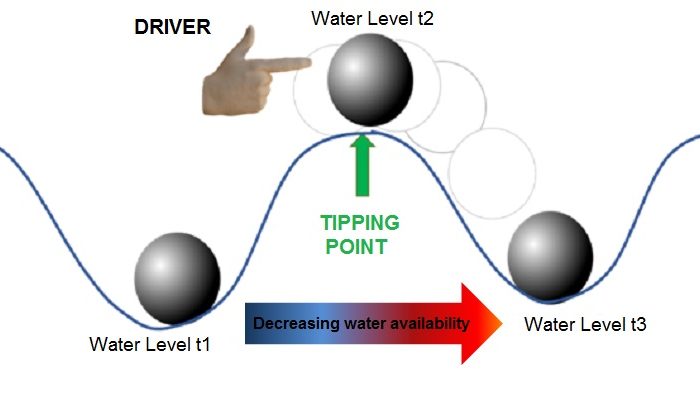
We live in a time of unprecedented pressure on water resources. The combination of drivers, such as human water use and land use, climate change by greenhouse gases and the human modification of other components of the Earth system coupled to the water cycle, may be pushing water resources beyond levels of sustainability at all spatial scales (Gleeson et al., 2020; Zipper et al., 2020). A particularly troubling perspective is that these drivers may push water availability to undergo dramatically large, persistent and unexpected changes that may be difficult or impossible to reverse, as can occur in social-ecological systems (Biggs et al., 2018).
From a system’s perspective, the term “tipping point” has been defined as the value of the critical threshold at which the future state of a system is qualitatively altered (Lenton et al., 2008), with important implications for humans, ecosystems and resources.
Regarding water, passing tipping points—if they occur—could lead, for instance, to chronic water scarcity or excessive water in some regions. It is thus a scientific priority to see if current and forthcoming changes in the water cycle have or will cross tipping points. It is no wonder that the identification of tipping points in the water cycle has been listed as one of the top 23 Unsolved Problems in Hydrology (UPH) by the International Association of Hydrological Sciences (IAHS) (Blöschl et al., 2019).
Tipping points in complex dynamical systems abound. They have been identified at local and regional scales and led to the collapse of fisheries, conversion of savannas into forests (Hirota et al., 2011; Staver et al., 2011), or desertification (Runyan et al., 2012). They have also been identified for the global scales for the climate system (Lenton et al., 2008), biosphere (Barnosky et al., 2012) and ecosystems (Hughes et al., 2013), among many others.
However, there seems to be a lack of use of the term “tipping point” in hydrological studies.
- Do we think that the term is considered rather “pseudoscience” and not appropriate for our studies?
- Is it difficult to identify them in hydrological systems?
- Or maybe they just do not exist?
Here below we briefly mention some possible explanations for this lack of use.
- Water changes everything, but nothing changes water. Tipping points in dynamical systems can be interpreted in terms of the response of the system to changes in one or more control variables. The control variables are those that generally represent the stressor or driver of change in a system, while the (one or more) response variables are the ones exhibiting the change or tipping point. In the literature of water-related tipping points, hydrologic variables are always taken as the control variables, since changes in water fluxes and stocks are known to act as stressors of socioecological systems, and the affected aquatic and terrestrial ecosystems as the response variables. However, there are fewer examples of hydrologic tipping points driven by non-hydrologic drivers.
- Jungle of tipping terminology. There is a jungle out there of system thinking terminology referring to or at least related to tipping points. For instance, have you ever heard of unstable equilibria, basins of attraction, bifurcations, critical transitions or thresholds, runaways, regime shifts or bistability?
- Too small scale to bother? Some of the unstable equilibria found in water-related studies (e.g., D’Odorico et al., 2007; Runyan and D’Odorico, 2010; Krueger et al. 2019; Peterson et al., 2009) are initially found at small time and spatial scales, probably not initially relevant for the stability of the Earth system or the water cycle. However, they might matter locally, regionally and even beyond!
- Where is the water? Cascading shifts in the monsoon system that lead to abrupt shifts in precipitation regimes and subsequent changes in ecosystem (e.g., the end of the green Sahara): this would sound as a water-related tipping point; however, it is mostly referred to as a climatic tipping point with regard to the circulation shift, and as an ecosystem tipping point related to the changes in vegetation cover.
- Does the term “hydrological tipping point” have any added value? Because hydrological shifts so often are associated with ecological and climatic shifts, it can be argued that there is no point of studying and discussing the tipping in the hydrological sub-system.
So, is hydrology in need of discovering its tipping points, or not?

Fernando Jaramillo is Assistant Professor and Docent in Hydrology at the Department of Physical Geography, Stockholm University. He is Baltic Fellow at the Baltic Sea Centre and Leader of Research Area for Hydrosphere, Cryosphere and Climate of the Bolin Centre for Climate Research.
Edited by Maria-Helena Ramos
References
- Barnosky, A.D., Hadly, E.A., …., Smith, A.B., 2012. Approaching a state shift in Earth’s biosphere. Nature 486, 52–58.
- Biggs, R., Peterson, G., Rocha, J., 2018. The Regime Shifts Database: a framework for analyzing regime shifts in social-ecological systems. Ecol. Soc. 23.
- Blöschl, G., Bierkens, …., Zhang, Y., 2019. Twenty-three unsolved problems in hydrology (UPH) – a community perspective. Hydrol. Sci. J. 0, 1–18.
- D’Odorico, P., Caylor, K., Okin, G.S., Scanlon, T.M., 2007. On soil moisture–vegetation feedbacks and their possible effects on the dynamics of dryland ecosystems. J. Geophys. Res. Biogeosciences 112.
- Hirota, M., Holmgren, M., Nes, E.H.V., Scheffer, M., 2011. Global Resilience of Tropical Forest and Savanna to Critical Transitions. Science 334, 232–235.
- Hughes, T.P., Carpenter, S., Rockstrom, J., Scheffer, M., Walker, B., 2013. Multiscale regime shifts and planetary boundaries. Trends Ecol. Evol. 28, 389–395.
- Krueger, E.H., Borchardt, D., Jawitz, J.W., Klammler, H., Yang, S., Zischg, J., Rao, P.S.C., 2019. Resilience Dynamics of Urban Water Supply Security and Potential of Tipping Points. Earths Future 7, 1167–1191.
- Lenton, T.M., Held, H., Kriegler, E., Hall, J.W., Lucht, W., Rahmstorf, S., Schellnhuber, H.J., 2008. Tipping elements in the Earth’s climate system. Proc. Natl. Acad. Sci. U. S. A. 105, 1786–1793.
- Peterson, T.J., Argent, R.M., Western, A.W., Chiew, F.H.S., 2009. Multiple stable states in hydrological models: An ecohydrological investigation: Multiple stable states in hydrological models. Water Resour. Res. 45.
- Runyan, C.W., D’Odorico, P., 2010. Ecohydrological feedbacks between salt accumulation and vegetation dynamics: Role of vegetation-groundwater interactions. Water Resour. Res. 46.
- Runyan, C.W., D’Odorico, P., Lawrence, D., 2012. Physical and biological feedbacks of deforestation. Rev. Geophys. 50.
- Staver, A.C., Archibald, S., Levin, S.A., 2011. The Global Extent and Determinants of Savanna and Forest as Alternative Biome States. Science 334, 230–232.
- Gleeson, T., Wang‐Erlandsson, …, Falkenmark, M., Famiglietti, J.S., 2020. Illuminating water cycle modifications and Earth system resilience in the Anthropocene. Water Resour. Res. 56,
- Zipper, S.C., Jaramillo, F., … , Wada, Y., Gordon, L., 2020. Integrating the Water Planetary Boundary with Water Management from Local to Global Scales. Earths Future 8, e2019EF001377.
